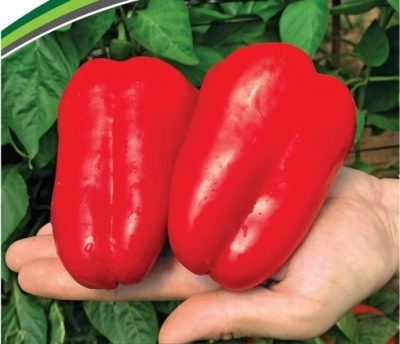
- Authors: Blokin-Mechtalin V.I.
- Year of approval: 2020
- Growth type: medium-sized
- Fruit shape: prismatic
- Fruit weight, g: 150
- Fruit color: in technical ripeness greenish-white, in biological ripeness dark red
- Ripening terms: early
- Average yield: 7.4 kg / m2
- Appointment: universal
- Growing conditions: greenhouse, open ground
The novelty Regor F1 is a sweet pepper with an extraordinary taste and beautiful shape. Therefore, the early ripe hybrid has already become popular among vegetable growers.
Breeding history
Regor F1 is a new hybrid sweet pepper variety, the result of domestic breeding. The author and originator of the 1st generation hybrid is the well-known specialist V.I. Blokin-Mechtalin. The culture was included in the State Register not so long ago, in 2020.
Description of the variety
Pepper culture Regor is distinguished by beautiful evened fruits of a red tone, having the correct proportions. In addition to excellent external data, peppers stand out for their excellent taste and rather high yield. And besides that, they are able to be well stored and transported without loss.
Characteristics of the appearance of plants and fruits
Pepper bushes of the hybrid variety Regor are of medium height, semi-spreading, compact. The plant itself does not take up too much space on the site. The arrangement of the fruits is drooping. Medium-sized dark green foliage, wrinkled leaf plates.
The peppers themselves are of the correct prismatic or trapezoidal shape. In a state of technical ripeness, they are painted in greenish-white tones, after ripening they become dark red. The fruits have beautiful proportions, they are glossy, weigh an average of 150 grams, and have a small diameter. There are subtle ribs. In the section, you can see 2-3 seed nests.
Considering that this is a hybrid, the seeds do not need to be preserved, they will not produce the expected offspring from them. The walls of the fruits are rather large - 6.5-7 millimeters, thanks to which the product can be transported over considerable distances.
Purpose and taste
The taste characteristics of Regor peppers are excellent, they note a very pleasant, sweet taste, aromatic, and also quite juicy pulp. Pepper is unusually tasty, even without waiting for full ripening, already upon reaching technical maturity. Regora fruits are versatile, but they are especially good for stuffing.
Ripening terms
Regor is an early hybrid variety. Only 95-110 days pass from germination to the onset of fruiting.
Yield
The average crop yield is 7.4 kg / sq. m.
Growing regions
According to the State Register, the culture is recommended for cultivation practically throughout the country. These are such regions as the northern and North-Western, Central and Central Black Earth regions, the Volga-Vyatka and North Caucasian, Middle and Lower Volga, as well as the Urals, Western and Eastern Siberia, the Far East.
Landing scheme
When planting the culture in question, it is optimal to use the following scheme: between the rows - 60-70 centimeters, and in the row between the bushes - 30-35 centimeters.

To get a large and tasty harvest of pepper, you need to take care of the seedlings in advance. When growing pepper seedlings, you need to correctly determine the sowing time, pre-sowing seed treatment, prepare the necessary container and soil.
Growing and care
Agrotechnology for the care and cultivation of a hybrid variety of domestic selection Regor is quite standard. To get a good harvest, you need to perform simple and uncomplicated activities. And first of all, it is watering and feeding the plants.
As it develops, the Regora bush is recommended to be tied to supports, since the trunk may fall due to large fruits.
Watering should be carried out at least once every 7 days, during the dry period - every 2 days. Use only warm and settled liquid for irrigation. Water should be moderate, the soil should not become too moist. Excessive water content can lead to fungal infections.
Regor requires regular fertilization, namely after 2 weeks. Pepper is fed with complex mineral products, such as "Kemira Lux", plus organic matter - potassium humate, herbal infusion, and mullein infusion.
After irrigation activities, as well as after rains, it is imperative to loosen, with parallel weeding.
At first after planting, the seedlings must be protected from the bright sun. This can be done with any white canvas.

To harvest a tasty and rich harvest of pepper, you need to comply with all the conditions of agricultural technology, and proper care begins with planting plants. Before planting pepper in open ground, it should be prepared. It is also important to take care of the seedlings and planting space in advance.




For good growth of pepper bushes and active fruiting, you need to regularly apply mineral and organic fertilizing to the soil. It is necessary not only to choose the right formulations, but also to use them at the right stage in the development of culture. The frequency of top dressing is always individual. It depends directly on the composition of the land on your site. The poorer the soil composition, the more often you will need to feed the pepper.
Disease and pest resistance
Pepper Regor belongs to hybrid varieties, therefore it has strong immunity. His resistance to most diseases is quite high. The culture resists viral pathologies such as tobacco mosaic and cucumber mosaic. In rare cases, it can be affected by late blight.
With careful implementation of all care procedures, the plant in question is rarely attacked by harmful insects. However, it is important not to forget about prevention. The development of infections, as well as the appearance of aphids, leafworms or other pests on the culture, should be prevented in time.

Pepper is one of the most common vegetables in home gardens. This culture is quite stable and unpretentious. However, under certain conditions, this plant can suffer from infections and harmful insects.Before treating peppers for diseases or pests, you need to find out the cause of the problem, otherwise the treatment may be ineffective.





















































































